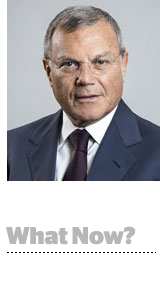 Here’s today’s AdExchanger.com news round-up… Want it by email? Sign up here.
Here’s today’s AdExchanger.com news round-up… Want it by email? Sign up here.
WPP Breakup
What will WPP do without CEO Martin Sorrell? One school of thought, highlighted by Bloomberg, predicts a board-led breakup of WPP’s more than 400 operating companies as it “loses the man holding the empire together.” Kantar is the most obvious target for divestment, The Independent reports, as Sorrell has said himself that the $4.3 billion custom research unit has been slow to realize synergies with the rest of the holding company [AdExchanger coverage]. Kantar has always been a core part of Sorrell’s vision, so divesting it would be a huge strategic shift for the company. But with WPP Chairman and corporate cost-cutter Roberto Quarta, aka “Bob the Knife,” at the helm, it’s unclear whether WPP has the patience to wait out Sorrell’s long-term vision in favor of short-term growth, WSJ reports. According to The Guardian, breaking up the group could net shareholders $27 billion. All of the uncertainty caused WPP’s stock to drop 6.5% on Monday, wiping $1.2 billion off of WPP’s market value, reported The Times.
Big Shoes To Fill
Meanwhile, WPP’s search for a new leader begins. The company has brought on recruitment firm Russell Reynolds to replace Sorrell, The Guardian reports. While many industry observers are speculating that Sorrell’s successor will come from within the WPP family, hiring an outside firm may help the holding company expand its search outside the company. But what’s next for Sir Martin, who “is almost never incommunicado, he replies to emails at lightning speed and is a consummate networker,” asks Sky News. That’s unclear, but he’ll have to channel that restless energy somewhere – and without a noncompete clause in his contract, he may do just that. More.
Who Speaks?
Sorrell has been such a seminal figure in the ad industry that his exit casts uncertainty on the entire holding company sector. Digiday posits that Sorrell’s exit could lead the holding company model, already under pressure from shrinking margins, cumbersome operating models and competitive silos, to cease to exist altogether. More. And then there’s the question of who will speak up for the industry against the power of Facebook and Google, which Sorrell famously dubbed “frenemies” over a decade ago. “At the very least, his role and voice across the industry had outsize impact,” said Jason Kint, CEO of Digital Content Next. “So we don’t know at this point what will fill that from the buy side. There probably was no company more in a position better to weaken the duopoly.” More.
Chugging Along
While ad land’s focus is trained on Sir Martin’s sudden departure from WPP, Omnicom reported earnings Tuesday with revenues growing marginally, by 1.2% to $3.6 billion. Read the release. North America was flat due to client losses and spending cuts in the region, CEO John Wren told investors on the call. Omnicom’s advertising unit grew 1.6%, led by media agencies PHD and Hearts & Science, partly offset by weakness at OMD, and CRM consumer experience was up 6.9%. When asked by investors whether or not Wren will consider acquiring some of WPP’s core assets, he said that’s not a “key focus” of the company’s acquisition strategy, reports Alex Bruell for The Wall Street Journal. “In many ways, I have a great deal of respect for Martin,” Wren said. “I know he was in the process of evaluating his own portfolio. I don’t know what conclusion the new leadership will reach.” More.
Oldest Tricks In The Book
Why and how does Facebook track people online if they aren’t logged on or don’t have Facebook accounts? David Baser, Facebook’s product management director, details the data Facebook collects on non-users, including browser tracking via its “like” and “share” buttons, its login feature that allows apps or venues to enroll new sign-ups and a measurement pixel advertisers can put on their sites. Read the blog post. It’s partly about security standards – like knowing to ask verification questions to potential bots or bad actors trying to access an account. The main point, though, is that online platforms like Twitter and LinkedIn have similar features. Google Analytics in particular tracks online browsing regardless of whether users are logged in to Google services, and the competition would like to see a harsher spotlight on the Google elephant in the room, not just the 400-pound Facebook gorilla.
But Wait, There’s More!
- How To Eliminate Bias In Data-Driven Marketing – Adweek
- Digital Remedy Buys CrowdHere Creative Collective – release
- Beauty Giants Snap Up Tech To Reach New Consumers – Bloomberg
- AppOnboard Raises $15M Series A – release
- WTF Is The Consent Act (In The US Senate)? – Digiday
- Adidas To Close Stores In Bid To Double Ecom Sales – Pymnts
- Dataxu Opens TotalTV Video Ad Solution For Broadcasters – release
- US Tech Caught In Crossfire Of China Trade Fight – WSJ
- After Abruptly Shutting Down, LittleThings Is Back – Business Insider
You’re Hired!
- TripleLift Builds Adds To Publisher, Mobile Growth Leadership – release
- Mobile Posse Hires Steve Drill As CTO – release
- Rebecca Sykes Tapped As Mofilm Global CEO – The Drum
- Publicis Unites EMEA, APAC Groups Under CEO Gerry Boyle – Campaign
- Iponweb Expands Client Services Leadership In US – release
- OOH Agency Billups Appoints David Krupp As CRO – release











